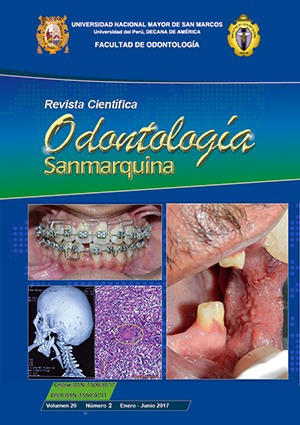In vitro study of the relation between the apical foramen and anatomical apex
DOI:
https://doi.org/10.15381/os.v20i2.13925Keywords:
Anatomy, Endodontics, Root canal therapy, Tooth apexAbstract
Objective: To evaluate the relationship between the position of the apical foramen and the anatomic apex in uniradicular teeth. Materials and method: In this vitro study that included 71 teeth between incisors, canines and premolars, all of them were uniradicular. The position of the apical foramen (vestibular, palatal / lingual, mesial and distal) was evaluated as well as the distance from the apical foramen to the apex of the anatomic apex through an electronic Vernier. Results: In thirty-two dental pieces (45.1%) coincided the location between the apical foramen and anatomical apex; in 40 (56.4% ) the apical foramen was found at vestibular and palatal / lingual levels, In teeth where there was concordance, the largest amount was found at the level of the upper central incisors (31.3%). The distance between the position of the apical foramen and the anatomical apex was 0.36±0.41 mm. Conclusions: The apical foramen is more frequent at the vestibular and palatine / lingual levels. The coincidence between the position of the apical foramen and the apex of the anatomical apex is present in 45% of cases. The average distance between both anatomical structures was 0.36±0.41 mm; this distance being greater at the upper premolar.Downloads
Downloads
Published
Issue
Section
License
Copyright (c) 2017 Piero Olivera-Rojas, Wendy Lugo-Huertas, Graciela Pumahualcca-García, Rosa Lara-Verástegui, Pamela Quispe-Romero, Yuri Castro Rodríguez

This work is licensed under a Creative Commons Attribution-NonCommercial-ShareAlike 4.0 International License.
AUTHORS RETAIN THEIR RIGHTS:
a. Authors retain their trade mark rights and patent, and also on any process or procedure described in the article.
b. Authors retain their right to share, copy, distribute, perform and publicly communicate their article (eg, to place their article in an institutional repository or publish it in a book), with an acknowledgment of its initial publication in the Odontología Sanmarquina.
c. Authors retain theirs right to make a subsequent publication of their work, to use the article or any part thereof (eg a compilation of his papers, lecture notes, thesis, or a book), always indicating the source of publication (the originator of the work, journal, volume, number and date).




















